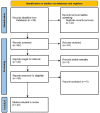Artificial Intelligence's Use in the Diagnosis of Mouth Ulcers: A Systematic Review
- PMID: 37842407
- PMCID: PMC10576017
- DOI: 10.7759/cureus.45187
Artificial Intelligence's Use in the Diagnosis of Mouth Ulcers: A Systematic Review
Abstract
Artificial intelligence (AI) has been cited as being helpful in the diagnosis of diseases, the prediction of prognoses, and the development of patient-specific therapeutic strategies. AI can help dentists, in particular, when they need to make important judgments quickly. It can eliminate human mistakes in making decisions, resulting in superior and consistent medical treatment while lowering the workload on dentists. The existing studies relevant to the study and application of AI in the diagnosis of various forms of mouth ulcers are reviewed in this work. The Preferred Reporting Items for Systematic Reviews and Meta-Analyses (PRISMA) standards were followed in the preparation of the review. There were no rule violations, with the significant exception of the use of a better search method that led to more accurate findings. Using search terms mainly such as AI, oral health, oral ulcers, oral herpes simplex, oral lichen planus, pemphigus vulgaris, recurrent aphthous ulcer (RAU), oral cancer, premalignant and malignant disorders, etc., a comprehensive search was carried out in the reliable sources of literature, namely PubMed, Scopus, Embase, Web of Science, Ovid, Global Health, and PsycINFO. For all papers, exhaustive searches were done using inclusion criteria as well as exclusion criteria between June 28, 2018, and June 28, 2023. An AI framework for the automatic categorization of oral ulcers from oral clinical photographs was developed by the authors, and it performed satisfactorily. The newly designed AI model works better than the current convolutional neural network image categorization techniques and shows a fair level of precision in the classification of oral ulcers. However, despite being useful for identifying oral ulcers, the suggested technique needs a broader set of data for validation and training purposes before being used in clinical settings. Automated OCSCC identification using a deep learning-based technique is a quick, harmless, affordable, and practical approach to evaluating the effectiveness of cancer treatment. The categorization and identification of RAU lesions through the use of non-intrusive oral pictures using the previously developed ResNet50 and YOLOV algorithms demonstrated better accuracy as well as adequate potential for the future, which could be helpful in clinical practice. Moreover, the most reliable projections for the likelihood of the presence or absence of RAU were made by the optimized neural network. The authors also discovered variables associated with RAU that might be used as input information to build artificial neural networks that anticipate RAU.
Keywords: artificial intelligence; dentistry; oral medicine; oral ulcers; review; systematic.
Copyright © 2023, Tiwari et al.
Conflict of interest statement
The authors have declared that no competing interests exist.
Figures
Similar articles
-
Beyond the black stump: rapid reviews of health research issues affecting regional, rural and remote Australia.Med J Aust. 2020 Dec;213 Suppl 11:S3-S32.e1. doi: 10.5694/mja2.50881. Med J Aust. 2020. PMID: 33314144
-
Artificial Intelligence Techniques: Analysis, Application, and Outcome in Dentistry-A Systematic Review.Biomed Res Int. 2021 Jun 22;2021:9751564. doi: 10.1155/2021/9751564. eCollection 2021. Biomed Res Int. 2021. PMID: 34258283 Free PMC article.
-
Mapping the Use of Artificial Intelligence-Based Image Analysis for Clinical Decision-Making in Dentistry: A Scoping Review.Clin Exp Dent Res. 2024 Dec;10(6):e70035. doi: 10.1002/cre2.70035. Clin Exp Dent Res. 2024. PMID: 39600121 Free PMC article.
-
Deep learning algorithms for classification and detection of recurrent aphthous ulcerations using oral clinical photographic images.J Dent Sci. 2024 Jan;19(1):254-260. doi: 10.1016/j.jds.2023.04.022. Epub 2023 May 2. J Dent Sci. 2024. PMID: 38303872 Free PMC article.
-
Evaluation of the content quality of websites for recurrent aphthous ulcers and oral lichen planus.BMC Oral Health. 2017 Dec 29;17(1):170. doi: 10.1186/s12903-017-0467-1. BMC Oral Health. 2017. PMID: 29284468 Free PMC article.
Cited by
-
Study Among Dentists of Udaipur Regarding their Awareness Among Artificial Intelligence in Oral Medicine and Radiology: A Cross-Sectional Study.J Pharm Bioallied Sci. 2025 May;17(Suppl 1):S884-S886. doi: 10.4103/jpbs.jpbs_411_25. Epub 2025 Apr 25. J Pharm Bioallied Sci. 2025. PMID: 40511135 Free PMC article.
-
Effect of Advanced Platelet-Rich Fibrin and Concentrated Growth Factor on Tissues Around Implants in the Maxillary Anterior Region.J Pharm Bioallied Sci. 2024 Jul;16(Suppl 3):S2191-S2193. doi: 10.4103/jpbs.jpbs_137_24. Epub 2024 Apr 24. J Pharm Bioallied Sci. 2024. PMID: 39346231 Free PMC article.
-
Artificial Intelligence: A Snapshot of Its Application in Chronic Inflammatory and Autoimmune Skin Diseases.Life (Basel). 2024 Apr 16;14(4):516. doi: 10.3390/life14040516. Life (Basel). 2024. PMID: 38672786 Free PMC article. Review.
-
In vitro Evaluation of Titanium Exfoliation during Simulated Surgical Insertion of Dental Implants.J Pharm Bioallied Sci. 2024 Dec;16(Suppl 4):S3383-S3385. doi: 10.4103/jpbs.jpbs_856_24. Epub 2024 Oct 29. J Pharm Bioallied Sci. 2024. PMID: 39926857 Free PMC article.
-
Artificial Intelligence and Decision-Making in Healthcare: A Thematic Analysis of a Systematic Review of Reviews.Health Serv Res Manag Epidemiol. 2024 Mar 5;11:23333928241234863. doi: 10.1177/23333928241234863. eCollection 2024 Jan-Dec. Health Serv Res Manag Epidemiol. 2024. PMID: 38449840 Free PMC article. Review.
References
-
- A fast learning algorithm for deep belief nets. Hinton GE, Osindero S, Teh YW. Neural Comput. 2006;18:1527–1554. - PubMed
-
- Real-time classification on oral ulcer images with residual network and image enhancement. Guo J, Wang H, Xue X, Li M, Ma Z. IET Image Process. 2022;16:641–646.
Publication types
LinkOut - more resources
Full Text Sources

